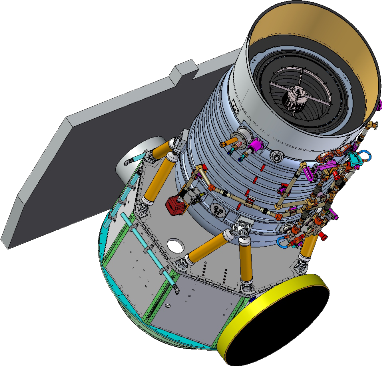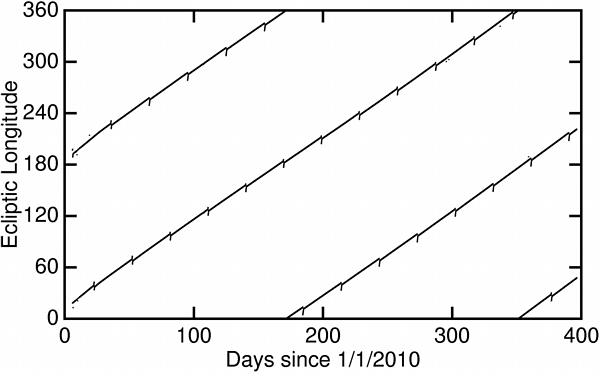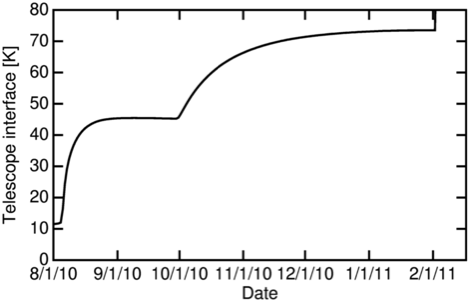 |
| Figure 1 - The WISE flight system in its operational configuration. |



AllWISE makes use of the Single-exposure images acquired by WISE during its original operational period in 2010 and 2011. The WISE flight system and survey strategy are described by Wright et al. 2010, AJ, 140, 1868 and in section III.1 of the All-Sky Release Explanatory Supplement. We provide a short summary of the WISE design and operations in this section, and describe the individual survey phases to set the context for the AllWISE program.
The WISE flight system, illustrated in Figure 1, consists of the spacecraft built by Ball Aerospace and Technologies Corp. and the payload built by the Space Dynamics Lab at Utah State University.
The spacecraft design was based on the BATC RS300 single string spacecraft and provides full three-axis control. Primary attitude information is provided by two star trackers. Angular momentum is stored using four reaction wheels, and excess momentum is dumped using magnetic torquer rods. Flight system power is provided by a 20 amp-hour lithium-ion battery that is charged using a fixed 500 watt solar panel. Two omni-directional S-band antennae receive commanding and transmit flight system telemetry. Payload science data are transmitted on the Ku-band via a fixed, high gain antenna. All uplink and downlink transmission is doen via the Trackking and Data Relay Satellite System (TDRSS).
 |
| Figure 1 - The WISE flight system in its operational configuration. |
An exploded view of the WISE payload is shown in Figure 2. The payload is a cryogenically cooled infrared instrument consisting of a 40-cm aperture telescope, scan mirror, and beam splitters to separate light into four bands. Light from the same sky field is measured simultaneously using four focal plane array (FPA) detectors, two 1024x1024 pixel mid-wave infrared (MWIR) HgCdTe FPAs and two 1024x1024 pixel long-wave infrared (LWIR) Si:As FPAs. During the 4-Band Cryogenic survey phase, the Si:As arrays operated at 7.8 K, and the HgCdTe arrays were operated at 32 K. The entire optical assembly is housed within the two-stage solid-hydrogen cryostat. The 26.8 liter inner or primary hydrogen tank cooled the two LWIR FPAs, while the 197 litere outer or secondary tank cooled the rest of the optics to less than 17 K. Following the exhaustion of cryogens in both tanks, the telescope and FPAs warmed until reaching radiative equilibrium with the sky.
During the 4-Band Cryo and part of the 3-Band Cryo phases, the Si:As arrays were thermally annealed twice per day to purge accumulated long-term latent images. During an anneal cycle, the Si:As FPAs were heated for two minutes to approximately 15K from their nominal 7.8K operating temperatures. W3 and W4 data were unusable for approximately 2000 seconds following the anneals because of elevated and rapidly changing detector dark current, read noise and responsivity. One of the daily anneals was performed during a TDRSS contact to avoid interrupting data collection. The second anneal was performed during normal survey observations, resulting in the effective loss of W3 and W4 data for approximately 2000 sec following the anneal.
 |
| Figure 2 - Exploded view of the WISE Payload. The aperture cover was ejected 15 days after launch. |
The raw pixel scale of the WISE array detectors is approximately 2.75"/pixel at the center of the fields of view. The W4 Si:As detector was binned 2x2 on board, so the effective scale was 5.25"/pix. The delivered WISE Point Spread Functions (PSFs) are described in section IV.4.c.iii.1 of the All-Sky Release Explanatory Supplement. Profiles through the major and minor axes of the PSFs are illustrated in Figure 3; The FWHM of the major axes of the PSFs are 6.1, 6.8, 7.4 and 12.0 arcsec in W1, W2, W3 and W4.
The WISE filter bandpasses and photometric system are described in section IV.4.h.v of the All-Sky Release Expanaltory Supplement. The relative spectral response functions profiles of the bandpasses are shown below in Figure I.2.a.4.
WISE surveys using a freeze-frame scanning technique similar to those used by 2MASS and the Spitzer MIPS instrument. The telescope scans the sky between the ecliptic poles in great (semi-)circles approximately perpendicular to the Earth-Sun line. As the telescope boresight scans continuously, an articulated scan-mirror within the Payload freezes the motion of the sky on the focal plane detectors while a Single-exposure is acquired by each of the four arrays. The scan mirror flies back to acquire the next sky position and a new exposure cycle begins each 11 seconds. The line-of-sight advances 42' per exposure resulting in ~10% overlap between adjacent exposures.
The detectors are read out non-destructively nine times with 1.1 second spacing for each Single-exposure. A single value for the fitted sample-up-the-ramp slope is computed on board for all pixels, and eventually downlinked as the Single-exposure image. The individual exposure times for the Si:As detectors was 8.8 seconds. The first readout of the HgCdTe (W1 and W2) is discarded, so their effective exposure time is 7.7 seconds.
The WISE orbital scan precession produces approximately 90% overlap in the ecliptic longitude direction between scans that are adjacent on the scan. Longitudes between subsequent scans are toggled forward and back slightly to smooth coverage variation due to the South Atlantic Anomaly (SAA), and are adjusted by approximately 10° biweekly to avoid the moon. See III.4.b in the All-Sky Release Supplement for details of these maneuvers. The actual ecliptic longitude of WISE scan semi-circles time are shown as a function of time in Figure 5 .
 |
| Figure 5 -Actual ecliptic longitude of the scan semi-circles as a function of day of 2010. |
The in-scan (ecliptic latitude) and cross-scan (ecliptic longitude) overlaps build up multiple independent exposures on each point of the sky over the course of the survey. Figures 6 and 7 illustrate the raw Single-exposure depth-of-coverage accumulated during the 4-Band Cryo and all survey phases, respectively. The most common depth achieved on the ecliptic plane was 12 during the 4-Band Cryo phase, and 24 during the entire mission. A total of 2,748,184 Single-exposures were acquired during all survey phases. However, only images that were of adequate quality were included in the AllWISE data processing, as described in V.1.b.
WISE collected 2.7 million individual exposures on the sky during its 390 days of surveying. Survey operations are divided into three phases defined by the state of its solid hydrogen cryogens and resulting telescope and focal plane temperatures. The AllWISE program combines the W1 and W2 Single-exposure data from all WISE survey phases, and the W3 and W4 from the 4-Band Cryo phase to produce an Atlas and Catalog with the best possible sensitivity, and to exploit the multiple sky coverage epochs for time domain studies. The three WISE/NEOWISE survey phases are described in the following subsections, and their start and end times and scans are summarized in Table I.2.c.1.
| Phase | UTC Start | UTC End | Scan Range | Framesets Acquired |
|---|---|---|---|---|
| 4-Band Cryo | 2010-01-07T01:45:14.1 | 2010-08-06T10:22:02.9 | 00712a-07101a | 1,491,686 |
| 3-Band Cryo | 2010-08-06T10:35:03.9 | 2010-09-29T18:39:36.8 | 07101b-08744a | 392,879 |
| Post-Cryo | 2010-09-29T18:41:15.8 | 2011-02-01T11:03:01.3 | 08745a-12514b | 901,274 |
WISE was launched on 14 December 2009 from the Space Launch Complex 2 at Vandenberg Air Force Base. After the in-orbit checkout period, the 4-Band Cryo survey phase began on 7 January 2010. During this phase, both inner and outer cyrogen tanks held solid hydrogen. The telescope was cooled by the outer tank to 17 K. The W3 and W4 Si:As arrays detectors were cooled by the inner tank to 7.6 K, and the W1 and W2 HgCdTe array detectors were heated and operated at 32 K. The 4-Band Cryogenic phase lasted for 206 days, until 6 August 2010 when the hydrogen in the outer tank was exhausted.
WISE completed its first full coverage of the sky on 17 July 2010, and surveyed approximately 20% of the sky (in the ecliptic longitude ranges 42.2°<λ<98.0° and 228.5°<λ<281.7°) a second time before the end of the 4-Band Cryo phase.
The WISE All-Sky Data Release was made on 24 March 2011. The All-Sky Release products included a set of 18,240 coadded, calibrated Atlas Images in the four WISE bands that cover the sky and a deep Source Catalog with positions, fluxes and ancillary information for over 563 million objects detected on the Atlas Images. The 4-Band Cryo individual Single-exposure images were also released along with a database of 9.4 billion detections made on the Single-exposure images.
The WISE 3-Band Cryo survey phase began on 6 August 2010 following the exhaustion of frozen hydrogen in the payload's outer cryogen tank. Approximately 30% of the sky was scanned during this phase in the ecliptic longitude ranges 42.2°<λ<98.0° and 228.5°<λ<281.7° over the next 54 days while the focal planes continued to be cooled by hydrogen ice in the inner cryogen tank. The telescope warmed from the 12 K maintained during the main mission and stabilized at 45 K due to residual cooling from the inner tank. Imaging data in the W1, W2 and W3 bands were acquired, but elevated thermal emission saturated the collected in the 22 μm W4 band. The 3-Band Cryo phase ended on 29 September 2010 when the hydrogen cryogens in the inner tank were exhausted. The telescope temperature profile during the 3-Band Cryo phase is shown in Figure I.2.c.1.
The W3 exposures time were decreased from 8.8 to 4.4, 2.2 and eventually 1.1 seconds during the 3-Band Cryo phase to avoid saturation due to the increasing telescope thermal emission. The W1 and W2 exposure times were maintained at 7.7 seconds. There was an interval shortly after the HgCdTe detectors warmed above the 32 K hold point when the rising thermal regeneration current in the W1 detector caused a signicant number of pixels to saturate on sky before the electronic bias could be adjusted. These saturated W1 frames were included in the AllWISE Multiframe Pipeline processing and produce problems in the W1 flux uncertainty measurements for sources that lie in the corresponding regions of the sky.
The WISE 3-Band Cryo Release was issued on 29 June 2012. The 3-Band Cryo Release products included 5,649 coadded Atlas Images and a Source Working Database with the positions and flux measurments for over 261 million sources detected on the Atlas Images. Also included were the Single-exposure image sets and a database of 3.7 billion detections measured on the Single-exposure images.
After the exhaustion of hydrogen in the WISE inner cryogen tank on 29 September 2010, continued survey operations were funded by the NASA Planetary Division as part of the NEOWISE program. This enabled the survey of the inner asteroid belt to be completed, and the search for candidate solar system small bodies to be continued.
During the NEOWISE Post-Cryo survey phase, the telescope and detectors warmed until they reached radiative equilibrium with the sky at approximately 73.5 K, as shown in Figure 8. The W1 and W2 HgCdTe detectors remained fully operational during this time with sensitivities close to those of the Cryogenic mission phases. The Si:As detectors were fully saturated by thermal emission and no useful W3 or W4 data were collected during this phase.
WISE scanned approximately 70% of the sky in the W1 and W2 bands during the Post-Cryo survey phase, in the ecliptic longitude ranges 89.4°<λ<221.8° and 280.6°<λ<48.1°. A complete second coverage of the sky was completed, with six month separation from the first sky coverage epoch. An additional 20% of the sky was observed for a third, independent epoch in those areas.
The NEOWISE Post-Cryo survey phase was ended on 1 February 2011 when data acquisition was halted. The flight system was placed into hibernation on 15 February 2011. During hibernation, WISE was in an inertial pointing mode that observed the Earth approximately half of the time, and the telescope temperature rose to approximately 200 K.
The NEOWISE Post-Cryo Data Release was made on 22 May 2013, and included 901,271 calibrated W1 and W2 Single-exposure images and a databse of over 7.3 billion source detections made on the Single-exposure images. The Post-Cryo Single-exposure images were not coadded for the release. AllWISE presents the first time these images are combined.
 |
| Figure 8 - WISE telescope interface flange temperature as 0 a function of date beginning just prior to the end of the 4-Band cryogenic survey phase. The 3-Band Cryo survey phase began on 6 August 2010 and ended on 29 September 2010 UTC. The Post-Cryo survey phase began on 29 September 2010 and ended on 1 February 2011 when data acqusition was halted. |
Last update: 6 December 2017